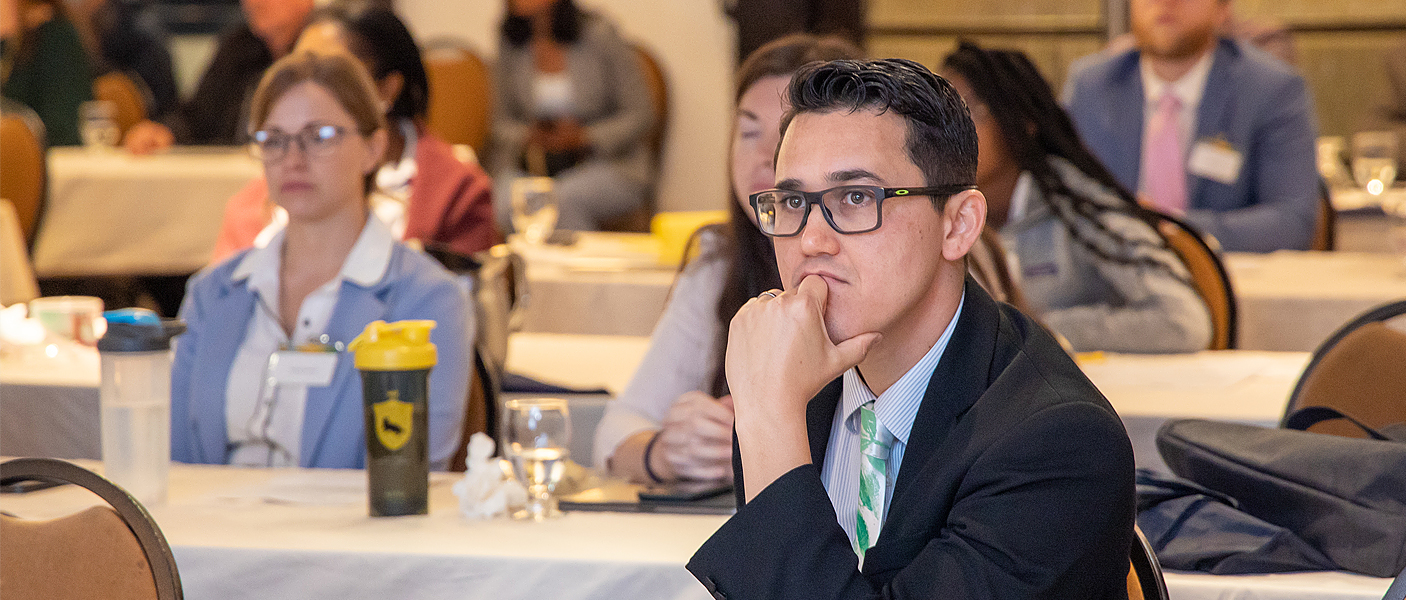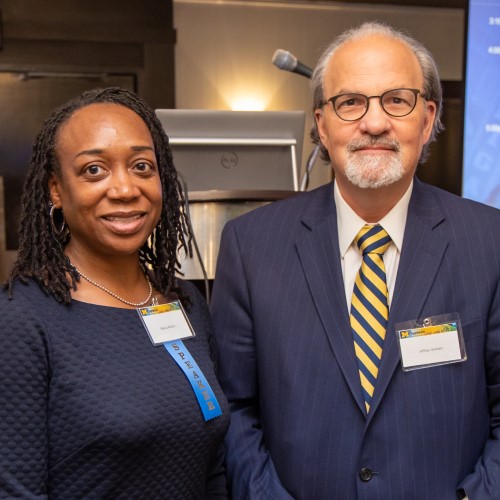

 The ballroom at Weber’s Inn was full, but not with dancers. Instead, it was filled with law enforcement agents, crime scene investigators, judges, forensic pathologists, coroners, medical examiners, pathologist assistants, social workers, and trainees from across the United States and Canada. This august group were meeting for the 2022 Advances in Forensic Medicine and Pathology Conference held May 19-20, 2022, in Ann Arbor, Michigan and sponsored by the University of Michigan Department of Pathology.
The ballroom at Weber’s Inn was full, but not with dancers. Instead, it was filled with law enforcement agents, crime scene investigators, judges, forensic pathologists, coroners, medical examiners, pathologist assistants, social workers, and trainees from across the United States and Canada. This august group were meeting for the 2022 Advances in Forensic Medicine and Pathology Conference held May 19-20, 2022, in Ann Arbor, Michigan and sponsored by the University of Michigan Department of Pathology.
The meeting began at 8:00 am on Thursday as Dr. Allecia M. Wilson, Director of Autopsy and Forensic Services at Michigan Medicine, welcomed Dr. Jeffrey Jentzen, former Director of Autopsy and Forensic Services and Professor Emeritus at Michigan Medicine, who kicked off a series of lectures related to epidemics. Jentzen began the meeting with a historical perspective of his experiences with infectious disease investigations beginning with Toxic Shock Syndrome (TSS) in 8 children. Through his investigation, he discovered that Influenza B was a precursor to TSS as it often led to staph infections. Tampon use in girls with these infections were predisposed to TSS. He then discussed the 1995 Parechovirus infection in infants and the Cryptosporidium outbreak the same year, both in Milwaukee, Wisconsin. He moved on to the H1N1 Influenza Epidemic of 2009 and concluded with the 2013 fungal meningitis outbreak in Tennessee.
Wilson then continued along this same path, discussing the COVID-19 pandemic and its impact on autopsy and forensic services at the Michigan Medicine morgue and Washtenaw and Livingston County Medical Examiner’s Office, which are considered more suburban/rural areas. In particular, she differentiated deaths of COVID, defined as persons who have the infection, which set into motion a series of biological processes that led to death, versus death with COVID, in which COVID infection did not play a direct role in the person’s death. She also discussed clinical research that led to discoveries and the publication of 38 COVID-related manuscripts to date, which were aimed at disseminating knowledge gained to aid in the care and treatment of COVID patients. Of note, none of the attendees at the conference had seen, knew of, or performed any pediatric autopsies on decedents who died of COVID. While there were some pediatric cases with COVID, COVID was not a contributing factor in those deaths.
Dr. Carl Schmidt, Chief Medical Examiner for the Wayne County Medical Examiner’s Office continued discussing the impact of COVID with a perspective from a large urban medical examiner’s office. Reported deaths jumped from 13,000-15,000 pre-COVID to more than 21,000 in 2020. The number of autopsies performed increased by 11%, which is the equivalent of a full-time forensic pathologist’s work. There were also significant increases in non-COVID fatalities caused by car accidents, homicides, drugs, and natural diseases. Schmidt noted that three-quarters of the deaths were in elderly people and many of these were co-infected with other respiratory viruses such as influenza and RSV. This led to high mortality rates among the elderly.
Donna Papsum, Forensic Toxicologist at NMS Labs, was next on the agenda, addressing the involvement of synthetic cannabinoids as cause or contributing cause of death. Discovered in the 1980’s these synthetic cannabinoids (SC) are often many times more potent than endocannabinoids, which are naturally occurring. There are hundreds of constantly changing compounds that make up the SC class, and these are purchased in powders, tablets, e-liquids for vaping, impregnated papers and clothing, solids, oils, and as a spray on natural cannabis. Unregulated and of inconsistent make-up and dosage, these can lead to arrhythmias, seizures, convulsions, panic attacks, paranoia, sickness, and death. With so many variations, Papsum discussed the need for standardized naming conventions, so the compounds can be easily identified.
The topic next moved to forensic applications of vitreous fluid, with Dr. Jacqueline Parai from the University of Ottawa. Vitreous fluid comes from the eye and is the main fluid used in postmortem biochemistry. Unlike the blood, the fluid in the eye is not affected by autolysis and as such, the chemical composition remains unchanged after death. She discussed use of this fluid and other autopsy findings for identifying whether the decedent died suddenly or following a prolonged period of stress.
Dr. Steve Clark, from Occupational Research and Assessment, rounded out the morning sessions discussing modernization of the National Vital Statistics System to standardize U.S. death certification and reporting. The goal is to standardize data sharing and interoperability using Health Level Seven (HL7) and Fast Healthcare Interoperability Resources (FHIR) protocols. The new Electronic Death Registration System (EDRS) system standardizes drug names and uses drop-down menus for cause of death. Use of the system has reduced duplicate death records in half and requires fewer keystrokes.
Following lunch, three break-out sessions were offered: Bereavement Counseling: New Concepts with Lisbeth Harcourt, MSV from Michigan Medicine; Judicial Immunity for Medical Examiners with the Honorable Stephanie Domitrovich, Sixth Judicial District of PA (Erie County), W. Milton Nuzum III, Supreme Court of Ohio, and Carl Schmidt, MD of Michigan Medicine; and Investigation of Deaths in the Arctic with Christopher Milroy, MD, University of Ottawa.
The late afternoon sessions resumed with Dr. Ponni Arunkumar, Chief Medical Examiner of the Cook County Medical Examiner’s Office, who presented on investigating the difficult suicide. In Cook County, 7% of deaths are suicides. Arunkumar discussed the importance of getting a history of risk factors, doing a thorough scene investigation as well as autopsy procedures. She presented a couple of case studies in which suicides at first appeared to be homicides, but with an extensive investigation, were determined to be suicides.
Case studies continued for the remainder of the afternoon, presented by Drs. Arunkumar, Parai, Schmidt and Eleftherios Vouyoukas (Forensic Pathology Fellow). Cases included a rapid-detox-related death, multiple gunshot wounds to the head, cerebral aneurysm, and multiple gunshot victims with a single bullet. The afternoon concluded with a poster session and reception.
Thursday evening, a delicious dinner was served and Dr. Allecia Wilson was honored with the Delores M. and John E. Finger, MD Forensic Lecture Award while top poster awards were given to Monique Micallef, Medicolegal Death Investigator for her poster, Scientific Identification, and Catherine Perez, MD (Pathology Resident) for her poster, Complex and Complicated Suicide. Drs. Jentzen and Wilson then presented on Expert Testimony in High-Profile Cases: The Floyd and Rittenhouse Cases. Wilson conducted the second autopsy in the Floyd case while Jentzen provided expert testimony on the Rittenhouse case.
Friday morning arrived bright and early as the conference resumed at 8:00 am with Dr. Vicki Daniel from Case Western Reserve University presenting on identifying disaster victims and how the process changed from family-based visual identification processes common in the Civil War to professional-based scientific identification that became the norm following the Cold War. James Cobb Jr., JD of Ajubita, Leftwich & Salzer, LLC, followed her with a discussion regarding defending nursing home owners who were accused of murder when their residents died during Hurricane Katrina in Louisiana. He discussed the importance of jury selection in getting to a fair and impartial verdict.
Following a brief break, Domitrovich and Nuzum returned to lead a discussion on implicit bias in the courtroom. They discussed different types of bias and how implicit bias, which is often unconscious, can lead to inequities of outcome in cases. A variety of scenarios were presented with audience participation. Parai then presented on adrenal insufficiency in forensic medicine and what that can look like at autopsy. She presented cases where the adrenal glands were atrophied and even virtually absent. Wilson and Michigan Medicine pathology assistant Alexis Snyder then offered a case on neonatal infections, including an infant who contracted herpes simplex virus during birth and his subsequent pathology and death.
After lunch, Jentzen walked the attendees through a variety of atypical gunshot wounds and how impact with intermediary targets changed the shape and trajectory of the bullet, which then changed the size and shape of the impact wound. He reviewed both normal, round entry wounds and atypical “D” shaped entry wounds along with the size and shape of the collar around the wounds. Dr. Christopher Milroy, Eastern Ontario Regional Forensic Pathology Unit, then took the podium and presented on stab wounds and how to differentiate suicide from homicide stab wounds. Suicides often have hesitation marks and fewer deep wounds while homicides tend to have wounds that show movement, and many times there are multiple deep wounds.
Schmidt was then joined by Stephanie Sommer from Michigan Medicine to review an automated organ and tissue recovery program used at the Wayne County Medical Examiner’s office. This program increased organ and tissue donations tenfold with little effort. The conference wrapped up with three additional case reports by Drs. Batoul Aoun, Martin Ishikawa and Chris Milroy. Aoun presented on two cases of fatal thrombocytic complications following the Johnson & Johnson-Jansen COVID vaccine, Ad2b.COV2.S. Both cases were female and presented with severe headaches followed by death in 11-12 days. The vaccine bound to antiplatelet factor 4, leading to thrombosis, which then led to thrombocytopenia and death. A NEU1 gene mutation is suspected as the underlying mechanism. The vaccine distribution was paused to investigate 6 cases, then resumed with a rare side-effect warning. Ishikawa presented on a relatively straight-forward, but unusual case from Hawaii, where a young man died while holding a cannister firework when it exploded, resulting in broken ribs, lacerated heart, and pulmonary bleeding. Finally, Milroy presented a case where a stroke victim suffered a fatal gunshot wound to the head from a .22 handgun. The original autopsy findings indicated a bullet path that could not be self-inflicted, and the husband was charged and convicted to 25-years to life. Milroy reviewed the case and found evidence of an error in the bullet path determination. Based on the new path, the case was likely suicide. The husband was released pending retrial, which was declined by the prosecutor.
Once again, the Advances in Forensic Medicine and Pathology Conference was “in the books” and attendees were encouraged to make plans to attend again next year – same time and same place. If next year’s conference is anything like this year, it won’t disappoint!